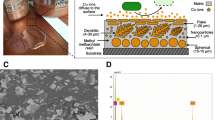Abstract
The use of copper for reducing nosocomial infections or healthcare-acquired infections (HAI) has been carried out in intensive care units (ICU) by replacing some objects generally made of stainless steel or other materials with solid pieces of copper. The authors’ proposal for a sustainable use of copper consists of introducing it in a “lamina + adhesive” format. This proposal has been tested in an ICU at the Ceuta Hospital in Spain. It has been found to provide an equally efficient solution as antibacterial material than the usual “solid” format, but with only a layer of 50 microns of copper, which is a high-cost and limited resource. After that intervention, some improvements are also proposed: a standardization of the pieces chosen to cover with a lamina of copper for saving material; and another method of replacement aiming to lower the time that the ICU cannot be used. To ensure that the proposed bonding method is harmless to human health and the adhesive does not interfere with the indoor environment by releasing toxic chemicals, the “lamina + adhesive” sheet has been further tested. The results and proposals are briefly shown.





Similar content being viewed by others
Data availability
The datasets used and/or analyzed during the current study are available from the corresponding author on reasonable request.
References
Aillón P, Parga-Landa B (2020) An improved proposal for using laminar copper as a biocidal material in hospitals in touch surfaces: a study on volatiles. In: Recent advances in environmental science from the Euro-Mediterranean and surrounding regions, 2nd edn. https://doi.org/10.1007/978-3-030-51210-1_362
Aillón P, Acha C, Domínguez JM (2017) Materiales e innovación en arquitectura sanitaria: cobre, barrera antibacteriana para espacios sanitarios. Anales de Edificación 3(3):55–61
Aillón P (2020) PhD Dissertation: La reducción de la carga bacteriana como criterio de diseño en arquitectura hospitalaria: el cobre en superficies de contacto ETSAM UPM 24 September 2020
Antimicrobial Copper Homepage, https://www.antimicrobialcopper.org, last accessed 2019/05/18
Casey AL, Adams D, Karpanen TJ, Lambert PA, Cookson BD, Nightingale P, Nightingale P, Miruszenko L, Shillam R, Christian P, Elliott TS (2010) Role of copper in reducing hospital environment contamination. J Hosp Infect 74(1):72–77
European Chemicals Agency (ECHA) (n.d.) Retrieved June 12–13, 2020 from https://echa.europa.eu/es/home
Girman JR, Hodgson AT, Newton AS, Winkes AW (1986) Emissions of volatile organic compounds from adhesives with indoor applications. Environ Int 12(1-4):317–321
Hüppe T, Lorenz D, Wachowiak M, Maurer F, Meiser A, Groesdonk H et al (2017) Volatile organic compounds in ventilated critical care patients: a systematic evaluation of cofactors. BMC Pulm Med 17(1):116
Huygh J, Clotman K, Malarvannan G, Covaci A, Schepens T, Verbrugghe W et al (2015) Considerable exposure to the endocrine disrupting chemicals phthalates and bisphenol-A in intensive care unit (ICU) patients. Environ Int 81:64–72
IPCS (2002) Global assessment of the state-of-the-science of endocrine disruptors. Geneva, Switzerland, World Health Organization, International Programme on Chemical Safety
Jalal AH, Alam F, Roychoudhury S, Umasankar Y, Pala N, Bhansali S (2018) Prospects and challenges of volatile organic compound sensors in human healthcare. ACS Sensors 3(7):1246–1263
LeBouf RF, Virji MA, Saito R, Henneberger PK, Simcox N, Stefaniak AB (2014) Exposure to volatile organic compounds in healthcare settings. Occup Environ Med 71(9):642–650
Lu CY, Lin JM, Chen YY, Chen YC (2015) Building-related symptoms among office employees associated with indoor carbon dioxide and total volatile organic compounds. Int J Environ Res Public Health 12(6):5833–5845
Oliver LC, Shackleton BW (1998) The indoor air we breathe. Public Health Rep 113(5):398
Salgado CD, Sepkowitz KA, John JF, Cantey JR, Attaway HH, Freeman KD, Sharpe PA, Michels HT, Schmidt MG (2013) Copper surfaces reduce the rate of healthcare-acquired infections in the intensive care unit. Infect Control Hosp Epidemiol 34(5):479–486
Scheepers PT, Van Wel L, Beckmann G, Anzion R (2017) Chemical characterization of the indoor air quality of a university hospital: penetration of outdoor air pollutants. Int J Environ Res Public Health 14(5):497
Schmidt MG, Attaway HH, Sharpe PA, John J, Sepkowitz KA, Morgan A et al (2012) Sustained reduction of microbial burden on common hospital surfaces through introduction of copper. J Clin Microbiol 50(7):2217–2223
Su FC, Friesen MC, Stefaniak AB, Henneberger PK, LeBouf RF, Stanton ML et al (2018) Exposures to volatile organic compounds among healthcare workers: modeling the effects of cleaning tasks and product use. Ann Work Expo Health 62(7):852–870
Sundell J (2004) On the history of indoor air quality and health. Indoor Air 14(s 7):51–58
Takigawa T, Horike T, Ohashi Y, Kataoka H, Wang DH, Kira S (2004) Were volatile organic compounds the inducing factors for subjective symptoms of employees working in newly constructed hospitals? Environ Toxicol 19(4):280–290
Vittori G (2002) Green and healthy buildings for the healthcare industry (p. 10). American Society for Healthcare Engineering of the American Hospital Association.
WHO (2012) State of the science of endocrine disrupting chemicals – 2012 ISBN: 978 92 4 150503 1
Yost EE, Euling SY, Weaver JA, Beverly BE, Keshava N, Mudipalli A et al (2019) Hazards of diisobutyl phthalate (DIBP) exposure: a systematic review of animal toxicology studies. Environ Int 125:579–594
Acknowledgments
The authors give thanks to Dr. Benigno Sánchez and Juan Gilaranz for the tests done at CIEMAT facilities.
Author information
Authors and Affiliations
Contributions
All authors contributed to the study conception and design.
Corresponding author
Ethics declarations
Conflict of interest
The authors declare that they have no conflict of interest.
Additional information
Responsible Editor: Lotfi Aleya
Publisher’s note
Springer Nature remains neutral with regard to jurisdictional claims in published maps and institutional affiliations.
Rights and permissions
About this article
Cite this article
Aillón García, P., Parga-Landa, B. An improved proposal for using laminar copper as a biocidal material in touch surfaces in a hospital Intensive Care Unit (ICU). Environ Sci Pollut Res 28, 16314–16322 (2021). https://doi.org/10.1007/s11356-020-11678-z
Received:
Accepted:
Published:
Issue Date:
DOI: https://doi.org/10.1007/s11356-020-11678-z




